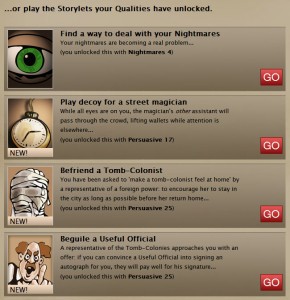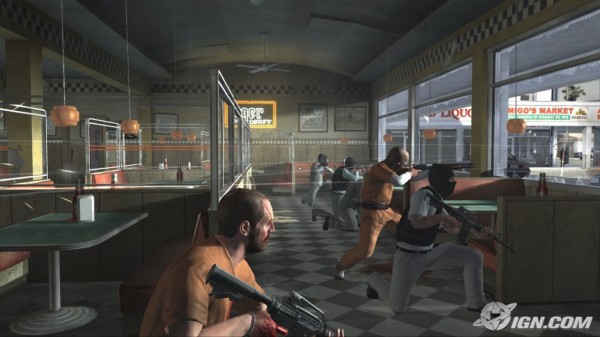So, I’ve seen that 17 minute Hitman Absolution walkthrough of the library level. It basically shows what looks like most of one level and Agent 47 expertly evading the police that’s on his tail. Now that gameplay section looks well crafted and interesting but what stuck out to me, in a good way, was the NPC dialogue that features prominently. In case you haven’t seen the video, here’s the YouTube version:
Tag Archives: Immersion
Storyworlds across Media conference
A few weeks ago I was at the Storyworlds across Media conference at the Johannes Gutenberg University in Mainz, Germany. This academic conference revolved around the creation of fictional universes and settings (storyworlds) through a variety of media. This conference was my first real contact with academic narratology and it was most definitely inspiring and interesting.
Over the course of three days I got to meet a set of interesting and intelligent people and talk about a intruiging topics. Of course there also were a number of papers being presented, some of which were quite intriguing while others were rather dry. Videos of all talks are supposed to be made available at the website, free of charge, later on. I’ll briefly try to highlight the, in my opinion, most valuable sessions so that you can give them a look once the videos are online.
Storyworlds across Media
from Marie-Laure Ryan
This introductory talk providfed a good overview over the idea of “storyworlds” and how they fit into theories of narratology. This lecture was a great start to the conference for someone new to the academic discourse on this topic. One of the things I specifically scribbled into my notes was her list of “constituents of storyworlds”, e.g. the things that together can create a storyworld:
- An inventory of existents
- A space with certain geographic features
- Physical laws
- Social laws and values
- Events. A history of changes that happen in the narrative
- Mental events
What I found especially interesting is that she specifically points out the fictional geography of storyworlds and it’s importance.
A Game of Thrones: Transmedial Worlds, Fandom, and Social Gaming
from Lisbeth Klastrup and Susana Tosca
 These two discussed a few transmedial events surrounding the launch of the Game of Thrones TV series, specifically the online games. They made a few interesting observations when it came to the different target groups, how they overlap and interact. Using some low-fi data mining they tried to figure out how readers, GOT enthusiasts, gamers and other people interlocked.
These two discussed a few transmedial events surrounding the launch of the Game of Thrones TV series, specifically the online games. They made a few interesting observations when it came to the different target groups, how they overlap and interact. Using some low-fi data mining they tried to figure out how readers, GOT enthusiasts, gamers and other people interlocked.
The Developing Storyworld of H. P. Lovecraft
from Van Leavenworth
A lecture dealing especially with the slightly odd nature of the Cthulhu mythos and it’s reincarnation in different “texts”. There are a few peciularities since the IP is no longer copyrighted and there is a wide range of different authors. It seems that it’s more of a brand that implies that the text provides a certain sense of world, unifying themes and returning elements. The latter could be locations (Arkham…) or characters (old ones…) but don’t have to be.
Strategies of Storytelling on Transmedia Television
from Jason Mittell
This lecture delved into different methods of sharing the storyworld of a series outside of the TV show. Jason explained two fundamentally different approaches using the examples of Lost and Breaking Bad. The former is expansionist, where the transmedial material expands on the world an adds new histories, characters and events. The Breaking Bad material on the other hand aims to “fold in on itself” to provide denser information about the character themselves, to help viewers get into their heads.
Jason also noted that there are three different kinds of tie-in games to movies and TV shows:
- Exploratory: These games allow you to explore the fictional storyworld yourself.
- Imitational: Games that allow you to “try on the skin” of the story characters. These often fail because the expected drama from TV and Movies is missing.
- Narratively: Games that try to retell the story of the movie in the game. This is almost never done for TV shows. Here the approach is usually to have the game be “one extraordinary episode”.
The Paradox of Interactive Tragedy: Can a Video Game have an Unhappy Ending?
from Jesper Juul
Here Jesper took a closer look at the elements that make up a tragedy and why it’s so difficult to recreate that in games. His theory is that this lies within the paradox of failure. Usually, when we as players succeed in some task within the game, we are happy, as is the protagonist. Likewise, when we fail we are frustrated and suffer, as does our protagonist. In Tragedy however we need to delight at the failure and misfortune of the protagonist. Our long-term aesthetic desire for a well-rounded story has to overcome our short-term desire for the protagonist to succeed, something that’s quite strong in video games.
Cities of the Future (Deus Ex)
The following is a promotional video for the upcoming game Deus Ex that gives a (very) brief look behind the scenes. It contains a lot of pretty pictures and sheds some light on their approach to storyworld creation.
It’s pretty light on the content but I found the fact that they created 100 fictional brands for their world a nice detail. I do hope they provide more behind the scenes videos or maybe some interesting material bundled with the game/collector’s edition.
Meaningful Narrative Decisions in MMOs
So I’ve been playing the Web Game Echo Bazaar a lot lately and this sparked some thoughts about narrative design & story in MMO Web Games and common game design standards.
First off let’s talk about classic Role-Playing Games for a minute here. The key thing in many tabletop RPGs is the story; they’re all about telling a story together. They’re at their best, when the individual player has to take meaningful choices that shape the ongoing story. What makes these decisions so strong is that they are irreversible. Whatever you chose you have to live with, which will make you think more about how you play and act.
This is something that’s usually lost in video games. With the (expected) ability to save and load previous states of the game, a story decision loses much of it’s weight. You can decide one way, see the consequences, then load and chose the other options. This somewhat “cheapens” the decision because it makes it possible to evade the results of your actions. Games can somewhat work around that by delaying the consequences of an action. That way, by the time you hit the consequences you’re not as likely to go load a very old save game.
However the persistent and shared worlds of MMOs can help here. Actually it’s both a boon and a curse when it comes to narration. A boon since load/save features don’t really work with persistent worlds (and aren’t expected) MMOs have the potential to have meaningful narrative decisions. It’s not quite that easy though. The curse of the persistent world is that with so many players sharing a space it is difficult to create a story that feels unique and that can have any impact on the world, since it shouldn’t inconvenience the other players and their story.
 That’s where Web Games (and Echo Bazaar for that matter) come in though. Since these don’t represent a shared “physical” virtual space, the stories can feel a lot more intimate.
That’s where Web Games (and Echo Bazaar for that matter) come in though. Since these don’t represent a shared “physical” virtual space, the stories can feel a lot more intimate.
Echo Bazaar does quite a good job at this, presenting you with a wealth of narrative bits that you can choose to create what seems to be your own story. For example there are often options where you have multiple “tasks” leading up to one final decision.
Here the decision feels like it has much more narrative weight, since you can’t just go ahead and do it differently. Well at least that was what I thought when I first took one of these decisions. Unfortunately though this is greatly weakened by the fact that these composite tasks (multiple jobs leading to one decision) can be replayed for a while, allowing you to do the same thing over again.
So to put things in a nutshell: MMOs have the potential to present really meaningful narrative decisions to the player since decisions can be final.
Agree? Disagree? Debate!
No unjustified Murder
Following in the footsteps of the No Murder blogpost comes another tale of immersion.
This time it’s about Kane & Lynch: Dead Men, a third-person shooter where you take on the persona of ex-mercenary Kane. Be warned that this post may contain some spoilers for the game’s story.
The game opens up with a cinematic of Kane sitting in Death Row writing a letter. While he’s waiting for death he tries to open up to his estranged daughter whom he supposedly hasn’t seen for a long time. Kane is repentant and has accepted his fate. It seems as if he’s made peace with himself.
This is all quite well done, even if the drama is layed on a bit thick, and helped me identify with the character. Kane felt like a complex and believable person and not a two dimensional action hero. Just what you want from a gritty crime story. It was a great beginning to the game and story.
So Kane finishes his letter and gets onto the armored transport to his execution. Just to have a group of mercenaries stop the convoy and free him (including his fellow inmate Lynch). In the confusion and chaos the player can take control for the first time.
Under fire from a variety of cops, Kane is led to temporary safety and given a gun. The rest of the level consists of back alley chases and shootouts with the police until at the very end the gangsters are holed up in a donut shop waiting for their getaway vehicle.
And right there the immersion broke for me because when my version of Kane crawled out of the ruins of the wrecked armored car, he was still a repentant criminal. I (as a player) just didn’t want to shoot at the police. I wanted to get away without killing anyone. And I did manage to stay in cover and evade them (and have my allies mow them down without regret). At least until the scene with the Donut Shop.
Again my image of the protagonist as the narrative had presented him to me was diverging from the game mechanics. My Kane was not a peaceful man and he’d have no qualms about gunning down “bad guys” but he wouldn’t shoot cops. The problem though is that the game forces you to kill cops. A LOT of them. Almost the entire first half of the game is entirely made up of firefights with the police.
After playing Mirror’s Edge peacefully I actually surprised myself by taking the “no cops” stance in Kane & Lynch without really thinking about it. Normally I have no problem gunning down anything that moves as I’m an avid shooter player. Not so here though. My guess is that the game immersed me to such a degree that I wanted to get in character and act like the protagonist. Or at least my vision of him. Either that’s a compliment to the storytelling quality or it’s a holdover after having played Mirror’s Edge before… Or I’m just getting old and soft.
Regardless the reason I did in fact enjoy this experience until the break. I guess it’s not unlike when I’m playing a role-playing game. When I get into character I take actions that are in line with the personality of my protagonist and the narrative as a whole. Often these actions are not the best ones from a game-mechanics point of view. In RPGs I take this sort of behavior for granted but it doesn’t seem to happen that often in Video Games.
Now did you ever experience something similar?
No Murder
A couple months ago I began playing Mirror’s Edge. In the game you play Faith, an underground courier trying to uncover a conspiracy. A feature of the game is that you can finish it without shooting a single opponent. Motivated by this achievement and the challenge of doing so I decided to try and complete the game peacefully.
Well as peacefully as I could at least. There’s still a lot of enemies, mostly policemen, which Faith has to take down to continue. I restricted myself to fighting unarmed and even though I struggled I greatly enjoyed the experience and felt immersed. I guess playing peaceful, as was in tune with my version of Faith’s personality, helped me get into character.
In fact I emphasized so well with Faith that I was genuinely unsettled when at one point in the game I kicked an approaching cop and threw him off a roof. I had tried not to hurt someone and still it had happened. The game makes no distinction here and I was still well on my way to get the achievement but the death of the policeman was still an accident that had a much stronger emotional impact on me than the many other deaths in other games.
And again, later in the game I felt this immersion rear it’s head – and bump it against something. At one point Faith has to ambush a convoy and to do so her courier organisation supplies her with a high powered sniper rifle to do so. Wait, what? How the hell did the peaceful group of free runners get their hands on such a weapon? I don’t know why but I felt somewhat betrayed by and doubted the sincerity of the group. Who knows what I had transported accross the city before. Maybe I had become an unwitting party to weapons smuggling and terrorism?
This was a very odd feeling because I do not think there was any developer intent behind this: The group displays no nefarious ulterior motives during the story and most of it’s members (of the few you meet) are genuinely good guys. If it was intentional and would actually lead somewhere in the story, then it would have been a powerful but subtle method to communicate parts of the narrative. Maybe foreshadow a possible betrayal or deeper corruption.
However as it was, Faith still cooperated with her group normally as if nothing had happened. This is where Faith as portrayed by the game, and as visualized in my head, diverged a bit and my immersion took a few cracks.
Immersion vs. Flow?
I’ve just watched a lecture from Clint Hocking (thanks for the link, Beren) about the changing demographics and generations and their impact on the Game Design Industry, as developers, critics and of course audience shift. Clint takes a long time to build up to his important points but it shows an interesting perspective on the different trends of game design and well worth the hour it runs. It again features Clint’s rapid-fire style I’ve already seen at the GDC microtalks. Since I recommend it. why don’t you check it out right now?
IGDA-Montreal – Feb 09: Clint Hocking – The Next Generation Player
(Slides are available from Clint’s Website)
However while I enjoyed the lecture, I want to write about an aspect only partially related to the talk. At the very end of it Clint presents what he perecives to be one (of two) critical questions of Game Design: Immersion. The problem he says is that Generation X games focus on full-time, single-player immersion (something he exhaustively explored with Far Cry 2), while Generation Y games would propably have to shift the immersion model to accomodate a more multiplayer oriented, bite-size immersion. This made some of my brain cells fire.
Taking a look at the Generation X immersion, it seems to me that it’s aspriring to emulate the story-focused immersion model as is used by movies. In the cinema you sit down to experience a linear, uninterrupted experience. Sicne this is a passive media it makes it easy to just absorb and become immersed. Afterwards you mingle with the other moviegoers and discuss what you personally took away from the experience. The Generation X immersion focused, story heavy, single-player games tried to do the same. They create a nonstop reality to engage in and once you’re over you can discuss you personal experience with other players, arguing about different viewpoints and interpretations. This seems to be a somewhat flawed approach, because contrary to the movie experience, games are not a passive medium.
The difference is that the player can directly act and change the outcome of the game. There is this abstract layer of game elements that’s between the player and the game world, which regularly forces the player’s mindset into a different space than that of the story. This is propably because there are two forces at work:
There is the story based immersion into the narrative, plot and setting.
And there is flow, the immersion into the game mechanics.
While I’m not sure where I’m going with this, I found this to be an interesting observation. It’s clear that there are games that focus only on one of these feelings. For example many of the games from thatgamecompany such as the eponymous flOw or flOwer focus on the sensual immersion into the flow of the game’s rules, the moment to moment interaction. Other games try to focus more on the narrative immersion, trying to hide the game elements as much as possible. This however seems to be somewhat of a futile effort. Regardless of how much you hide the interactive elements, the player still has direct contact with them, since they are his interface. This is propably the reason why flow-only games (Tetris, Lumines, Peggle) without a detailed narrative pull in the player much deeper than games focusing much more on the immersion. There propably is a good middle ground here, where your game flow is intriguing and in sync with your narrative immersion.



